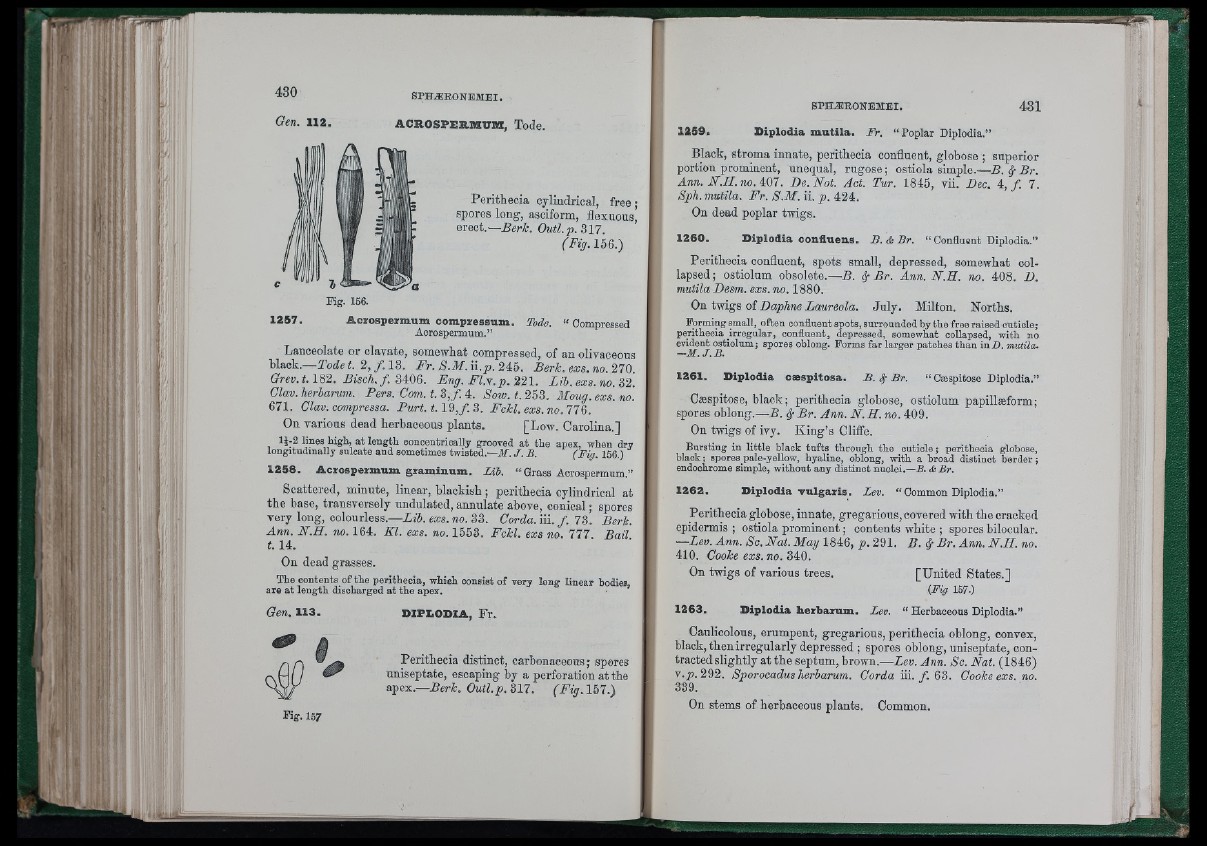
Vi
Gen. 1 1 2 .
SPHÆEONEMEI.
ACK.OSPERIHUM, Tode.
Perithecia cylindrical, free;
spores long, asciform, flexuous,
erect.—Berk. Outl. p. 317.
(Fig. 156.)
1 2 5 7 . A c r o sp e im um c om p r e ssum . Tode. “ Compressed
Acrospermum.”
Lanceolate or clavate, somewhat compressed, of an olivaceous
hlack.— Tode t. 2, f . 13. Fr. S .M .ii.p .2 4 5 . Berk. exs. no.276
Grev .t.l82. Bisch. f . 3466. Eng. FI.y. p . 221. Lib. exs. no. 32.
Clav. herbarum. Pers. Com. t. 3, f . 4. Sow. t. 253. Moug. exs. no.
671. Clav. compressa. Purt. 1.19, f . 3 . Fckl. ex s.no.776.
On various dead herbaceous plants. [Low. Carolina,]
l i -2 lines high, at length concentrically grooved at the apex, when dry
longitudinally sulcate and sometimes twisted.—iH. J. B . (Fig. 156.)
1 2 5 8 . A c zo sp e zm um g iam in nm . Ub. “ Grass Acrospermum.”
Scattered, minute, linear, blackisb ; perithecia cylindrical at
tbe base, transversely undulated, annulate above, conical; spores
very long, colourless.—Lib. exs. no. 33. Corda. iii. / . 73. Berk.
Ann. N .H . no. 164. Kl. exs. no. 1553. Fckl. exs no. 777. Bail
1.14.
On dead grasses.
The contents of the perithecia, which consist of very long linear bodies,
ar» at length discharged at the apex.
Gen. 1 1 3 . DIPLODIA, F r.
Perithecia distinct, carbonaceous; spores
nniseptate, escaping by a perforation at tbe
apex.—Berk. Outl.p. 317. (F ig .157.)
1 2 5 9 .
SPHÆEONEMEI. 4 3 1
D ip lo d ia m u t ila . Fr. “ Poplar Diplodia.”
Black, stroma innate, perithecia confluent, globose ; superior
portion prominent, unequal, rugose; ostiola simple.—B . ^ B r .
Ann. N .H . no. 467. He. Not. Act. Tur. 1845, vii. Dec. 4, f . 7.
Sph. mutila. Fr. S.M. ii. p. 424.
On dead poplar twigs.
1 2 6 0 . D ip lo d ia c o u flu en s. B . A Br. “ Confluent Diplodia.”
Peritbeoia confluent, spots small, depressed, somewbat collapsed
; ostiolum obsolete.—B. / Br. Ann. N .H . no. 408. D.
mutila Desm. exs. no. 1880.
On iyñg& oi Daphne Laureola. July. Milton. Norths.
Forming small, often confluent spots, surrounded by the free raised cuticle;
peritheoia irregular, confluent, depressed, somewhat collapsed, with no
evident ostiolum; spores oblong. Forms far larger patches than inD. mutila.
—M. J. B.
1261. D ip lo d ia cæ sp ito sa . B . 4 Br. “ Cæspitose Diplodia.”
Cæspitose, black; perithecia globose, ostiolum papillæform;
spores oblong.—B. / Br. Ann. N . H. no. 409.
On twigs of ivy. K in g ’s Cliffe.
Bursting in little black tufts through the cuticle; perithecia globose,
black ; spores pale-yellow, hyaline, oblong, with a broad distinct herder ;
endoohrome simple, without any distinot nuclei.—B .A B r .
1 2 6 2 . D ip lo d ia v u lg a z is . Bev. “ Common Diplodia.”
Perithecia globose, innate, gregarious, covered witb the cracked
epidermis ; ostiola prominent ; contents white ; spores bilocular.
—Lev. Ann. Sc. Nat. May 1846, p . 291. B. 4 S r . Ann. N .H . no.
410. Cooke exs. no. 340.
On twigs of various trees. [United States.]
(Fig 157.)
1 2 6 3 . D ip lo d ia hezbazum. Lev. “ Herbaoeoua Diplodia.”
Caulioolous, erumpent, gregarious, perithecia oblong, convex,
black, then irregularly depressed ; spores oblong, nniseptate, contracted
sligbtly at tbe septum, brown.—Lev. Ann. Sc. Nat. (1846)
y.p . 292. Sporocadus herbarum. Corda iii. f. 63. Cooke exs. no.
339.
On stems of herbaceous plants. Common.
O'